TGA - True Vision Targa File. A storage format for bit-mapped video image.
thangka - Alternate spelling of tanka.
theater, theatre, theatrical, and drama
theme, thematic - A theme is a unifying topic, and might be a subject or an idea. An artist, educator, writer, gallery or museum can select a theme as a means of choosing or ordering subject matter for a body of work -- which will be or has been produced, perhaps to be studied in an art education program, or to be displayed in an exhibition.
As Mary Erickson (Professor of Art Education, Arizona State U) has pointed out, art educators use non-art-specific themes to organize content and as a basis for selecting artworks to be presented within lessons or units because themes help students integrate their understanding by (as Erickson has put it):
Erickson suggests that a theme will be most effective when it is articulated both as a general theme in life and as a theme in art. Broad based themes that have concerned people from all times and cultures emerge as participants reflect on the meaning of artworks made in different times and cultures.
Examples of themes in art:
Examples of non-art-specific themes around which Erickson suggests educators design units of study:
Other examples of themes in life:
Also see abecedarian, chronology, composition, interdisciplinary, sequence, and taxonomy.
theory - A set of abstract rules, ideas, and principles that explain a particular subject, as opposed to actual practice. Or, an unproved assumption; a hypothesis or conjecture assumed for the sake of argument.
(pr. THEE-ə-ree)
Quote:
Also see aesthetics, androgyny, archetype, art, art criticism, art therapy, artworld, Bloom's Taxonomy, change, cognitive, color, deformalism, emotionalism, empiricism, entropy, epistemology, ergonomics, feminism and feminist art, feng shui, formalism, game theory, ideal, imitationalism, interdisciplinary, isms and -ism, issue, linear perspective, manifesto, mathematics and art, meta-cognition, motivation, multiple intelligence theory, music, mystery, new media, ontology, optical illusion, optical mixing, perfection, phenomenology, postmodernism, principles of design, Rayonism, right brain, science and art, space-time, Stages of Artistic Development, standards, Stendhal syndrome, subliminal message, theater, time, and unconscious.
thermoplastics - Plastics which soften when they are heated and harden as they cool without changing their basic properties. Acrylics and polyurethane are examples of this type of plastic.
thermosetting - A term which refers to plastics, such as polyester and epoxy resins, which require the presence of heat in a forming process, but which then set hard and cannot be remolded. Also see temperature.
thesis - A proposition that is maintained by argument. Or, a text promoting an original point of view as a result of study, especially as a requirement for academic advancement.
Also see antithesis.
thickness - See density, depth, dimension, direction, height, length, mass, measure, mil, overlapping, perspective, shape, space, weight, and width.
 third
eye - According to Hindu legend, Shiva acquired his third eye
when Parvati, Shiva's wife, covered his eyes as a joke with her
hands. Suddenly all the world went dark. And instantly a bundle
of light appeared on the forehead
of the god, to replace the sun. The third eye is the sixth (second-highest)
of the seven chakras, also known as the Brow Chakra or Anja. It
is located between the eyebrows and is the seat of intuition and
awareness. It governs intuition through inner and outer sight,
visions and dreams. It is a pathway to wisdom which allows us
to learn from our experiences and put them into perspective. its
color is indigo blue. Blockages to the third eye chakra manifest
as sinus or eye problems.
third
eye - According to Hindu legend, Shiva acquired his third eye
when Parvati, Shiva's wife, covered his eyes as a joke with her
hands. Suddenly all the world went dark. And instantly a bundle
of light appeared on the forehead
of the god, to replace the sun. The third eye is the sixth (second-highest)
of the seven chakras, also known as the Brow Chakra or Anja. It
is located between the eyebrows and is the seat of intuition and
awareness. It governs intuition through inner and outer sight,
visions and dreams. It is a pathway to wisdom which allows us
to learn from our experiences and put them into perspective. its
color is indigo blue. Blockages to the third eye chakra manifest
as sinus or eye problems.
thixotropic - The capacity of fluids to decrease in stiffness when stirred. Such fluids are produced as oil painting media and are included in oil primers. They tend to be fast-drying.
thong deng - In South East Asian tradition, a casting alloy containing a high percentage of copper.
Also see tombac.

![]() 3-bit image - A digital image with eight bits allocated for the storage of each pixel, meaning eight monochromatic colors are possible — a
3-bit image - A digital image with eight bits allocated for the storage of each pixel, meaning eight monochromatic colors are possible — a gray scale (or value scale) of eight values.
Also see 1-bit image, 2-bit image, 4-bit image, 8-bit image, 12-bit image, 16-bit image, 24-bit image, and 32-bit image.
![]()

![]()
three-dimensional - Having, or appearing to have, height, width, and depth.
Also see chiaroscuro, compass rose, direction, form, illusion, mass, perspective, sculpture, shadow box, space, statue, two-dimensional, and wireframe.
Three Kingdoms - A period of Chinese history which lasted from 220 - 280 CE.
three-quarter view - A view of a face or any other subject which is half-way between a full and a profile view.
Examples:

Leonardo
da Vinci (Italian, 1452-1519), Head of the Virgin in Three-Quarter View Facing
Right, 1508-12, charcoal,
black and red chalks;
traces of framing line in pen and brown ink
at upper right; 8 x 6 1/8 inches (20.3 x 15.6 cm), Metropolitan
Museum of Art, NY.
Charles Lebrun (French, 1619-1690), Expressions of the Spirit's Passions: Anger, c. 1663, head three-quarters to the right, black pencil, width 25 cm, Louvre. See Baroque, expression, and Poussinisme.
![]()

![]()
British, Three-Quarter View of a Steam Locomotive Railway
Engine, late nineteenth century.
Also see cameo, frontal, portrait, profile, and silhouette.
throwing - In pottery, throwing means making a pot from a piece of clay on a potter's wheel.
thrust - The outward (lateral) force produced by the weight of an arch or vault. It is counterbalanced by buttress.
Also see architecture and structure.
thumbnail sketch or thumbnail image - A very small and loose drawing. In digital imaging, a small image usually derived from a larger one, also known as a browse image.
Examples of thumbnail drawings:

Eric Carle (American, contemporary), author
and illustrator of children's
books, Thumbnail Sketches for From
Head to Toe, c. 1999, pen
and ink on paper.
Taken altogether, these resemble a storyboard.
Also see derived image.
thymol - A general fungicide in common use in museums especially for the treatment of mold growth.
Also see art conservation and climate control.
tier - One of a series of rows placed one above another, or to arrange into a set of tiers, as are rows of seats in a theater.
Also see amphitheater, grid, height, and pattern.
TIFF - Tagged Image/Interchange File Format. In digital imaging, a file-storage format implemented on a wide variety of computer systems. Considered an industry standard, but so open that header information is used in many different ways. Also see GIF (Graphic Interface Format), JPEG (Joint Photographic Experts Group, and PICT (Macintosh Picture).
Also see GraphicConverter.
tile and tiling - A slab of hard material such as baked clay or plastic, laid in rows to cover walls, floors, and roofs. It is thin, and either flat, textured or in low-relief. It may either be single or considered as a group.
Examples:

Attributed to Kashan, Persia (Iran), Ilkhanid,
Tile, c. 1270-80, molded
and overglaze luster-painted composite body, height
14 3/4 inches (37.5 cm) width
14 1/4 inches (36.2 cm), Metropolitan Museum of Art, NY. See
Islamic art.

Persia (Iran) or central Asia, Mihrab,
late fifteenth or sixteenth century, glazed
ceramic tile, 106 1/2 x 89 inches (270.5 x 226.1
cm), Cincinnati Art Museum, OH. See mihrab.

England, Lambeth, c. 1690, Pill Slab with the Arms of the Society of Apothecaries and the City of London, cobalt blue, tin-glazed earthenware (Delftware), 10 5/8 x 9 5/8 inches (26.99 x 24.45 cm), Los Angeles County Museum of Art. Although a "pill slab" may not be a tile in every sense, it is in some essential ones. See coat of arms.
![]()

![]()
England, Tile, c. 1750, ceramic, delftware, Minneapolis Institute
of Arts. See cobalt.

England, Tile, c. 1750, ceramic, delftware, Minneapolis Institute
of Arts.

Grueby Faience Company, American, 1897-1910, Savin tree tiles, about 1902, terra cotta with multicolored glaze, Hood Museum of Art, Dartmouth College, NH.

Bernard Leach (English, 1887-1979), Lion Tile, 1973-4, lithograph on paper,
image: 43.5 x 52.1 cm, Tate Gallery, London. Leach produced this
glazed stoneware
tile at St. Ives, England, c. 1928. See pottery.
To tile is to cover with (or lay) tiles. In digital imaging, tiling is repeating a graphic in an all-over pattern. An artist noted for his explorations of graphic tiling was Maurits Cornelis Escher (Dutch, 1898-1972).
Internet resources concerned with tile and tiling:
Also see antefix, imbrication, mortar, mosaic, overlap, pique assiette (also called picassiette), plaque, slab construction, and tessellation.
tilt - To tilt is to rotate a camera up or down.
Also see cinema, cinematography, pan, panning shot, tracking shot, video, and zoom.
tin - A silvery gray, malleable metal, resistant to corrosion, much used in alloys. It is an essential ingredient in bronze and in pewter. Lead, when used for sculpture, is alloyed with it. It is also used in common solders. Painting on tin is often called tole. When used as a verb, tin refers to coating or plating with tin. Tin's symbol is Sn; atomic number 50; atomic weight 118.69; melting point 231.89°C; specific gravity 7.31; valence 2, 4.
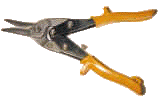
tinsnips - Shears with short blades used to cut through thin sheets of metal.
Example:

Walker Evans (American, 1903-1975), photographer,
Tin
Snips, 1955, black and
white photograph
from "The Beauties of the Common Tool," FORTUNE,
July 1955.
Also see scissors and steel sheet gauges.
tint - A soft and light color — one to which white has been added. For example, white added to green makes a lighter green tint. The illustration below diagrams colors of various values. Value changes from pure hues are called tints and shades. On the right, pure hues are marked by dots. The tints made from those hues are above them.

Tint can also refer to the name of whatever hue is dominant in a color. Something is tinted when color is added to it.
When light is projected, its color can be tinted by sending it through a filter.
The term "pastel" is used by some as a synonym for tints. First employed metaphorically by American fashion writers in 1899, "pastel" in this sense might be understood in context, but art writers generally avoid this usage to prevent their readers' confusion. Failure to distinguish pastels (tints) from pastels (the medium) results in ambiguity.
Other Internet resources concerned with tint:
Also see chiaroscuro, color, encaustic, highlight, monochrome, nuance, tone, and value.
tintype - A photographic process in which the negative image is produced on a thin coated plate of iron, which is why they are also known as ferrotypes. There is actually no tin involved. Tintypes first appeared in 1854.
Examples:

Unidentified photographer, Woman looking at framed tintype portraits, c. 1870, tintype with decorative paper mat, 12.4 x 7.7 cm, George Eastman House, Rochester, NY.
Unidentified Photographer, Man and Childs Hands, c. 1875, tintype, 7.8 x 4.9 cm Eastman Kodak House, Rochester, NY.
tip, tip in - To mount an insert, usually an illustration onto a page of a book, using an adhesive on the verso of the binding edge of a work on paper. What is most commonly tipped into an art book is a printed reproduction of an artwork.
tissue paper - A type of paper which is very thin and strong, available in many colors. Because of its pliable and translucent qualities, it is especially good for making collages. To adhere it to any of various supports, try using diluted glues or liquid starch.
Also see Japanese mending tissue.
titanium - An oxide used as a white pigment of great permanence and covering power. Usually extended with other whites to improve its brushing and drying properties.
An example of a building utilizing titanium:

Frank O. Gehry (American, 1929-), Guggenheim
Bilbao Museum, 1997, Bilbao, Spain. Much of its surface
consists of sheets of titanium, which here takes on a warm, light-gray
color (partly because of lighting
conditions? or patination?)
One critic said:
"The Guggenheim Museum Bilbao is a collection of interconnected
blocks housing galleries, an auditorium, a restaurant, a museum
store and administrative offices. These buildings have as their
central focus a single architectural composition."
Also see white lead.
title - Works of art and exhibits typically have titles attached to them — usually just one, but sometimes several. Sometimes these titles make sense and match the art; other times they are more like labels for cataloging purposes.
A study of titles of works of art might be related to what is known as onomastics, which is the study of the origins and forms of proper names and terms used in specialized fields, or the system that underlies the formation and use of proper names or terms used in specialized fields.
Quote:
Also see nomenclator, placeholder, and text.
tole - Decorative painting on tin objects, traditional in several cultures, including American. Toleware is tinware. Although similar painting is also done on wooden, glass, and plastic objects, it is more appropriate to describe such work simply as decorative painting. Tole is typically a folk craft, with images derived from pattern books. Most tole is done with oil paints, but some is also done with acrylic paints. There are brushes designed specifically for tole, but round and flat red sable brushes of many types are generally recommended.
Also see double loading, folk art, side loading, and ware.
toluene - Toluene is a liquid used as a solvent
and as a thinner for certain inks, paints, lacquers,
resins, cleaners, and adhesives. It is an organic liquid
with a sweet, benzene-like
odor, found in gasoline and aviation fuel. The most common use
of toluene is in the manufacture of benzene
and urethane. World-wide, there are many names used
for toluene. On any product's label, it may be easiest to identify
toluene by its Its unique identifier number assigned by the Chemical
Abstracts Service (CAS): 108-88-3. Toluene is very hazardous
because both as a liquid and as a vapor it is highly
toxic and flammable.
Keep out of the reach of children. Toluene presents a significant
public hazard as an environmental pollutant, especially to air
and water. In order to dispose of it, obtain advice from local
waste disposal authorities.
(pr. TAHL-yoo-een)
Also see clean up.
tombac - In South East Asian tradition, brass or a similar alloy.
Also see thong deng.
tonal key - Characteristics of color schemes that convey moods (psychological affects) and aesthetic effects.
Also see chroma key, contrast key, temperature key, and value key.
tone and tonality - A quality of a color, arising from its saturation (purity and impurity), intensity (brilliance and dimness), luminosity (brightness and dullness), and temperature (warm and cool); or to create such a quality in a color. To tone down is to make a color less vivid, harsh, or violent; moderate. To tone up is to make one become brighter or more vigorous. Tonality can refer to the general effect in painting of light, color, and shade, or the relative range of these qualities in color schemes.
Also see deep, monochrome, nuance, tint, and value.
tool - Any instrument or equipment used to produce or learn about art.
Examples:

Digital examples:
This is a "tools menu." Although
many of the tools found in it are typical of those available
to users of many graphics applications, this set can be found
in Adobe Illustrator 10. Notice that virtual versions of some
of the tools listed above can be found on this menu.
Quote:
Also see Praxis, preparator, placeholder, and technology.
tooth - A degree of surface roughness of texture which is adequate to allow for paints, adhesives, etc. to adhere.
topiary - The sculpting of live shrubs or trees into decorative shapes.
(pr. TOH-pee-ə-ree)
Example:

England, Squirrels on bases, c. 2002, yew topiary,
Gardens at Great Dixter.
![]()

![]()
England, Lion, topiary, a mane of
long grass.
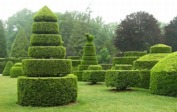
American, Topiary
Trees, 2003, Longwood Gardens, PA.

![]()

Jeff Koons, Puppy,
(seen here at two times), 1992, height
43 feet, steel frame supporting 25 tons of soil, a fabric planted
with 60,000 - 70,000 flowering annuals, watered by an internal
irrigation system, Rockefeller Plaza, New York, and Sydney, Australia.
It was also exhibited at the Guggenheim Bilbao, Spain, at that
museum's opening. See Neo-Geo.
Also see environment art.
topography - A description, model, or drawing of mountains, valleys, hills, rivers, roads, bridges, and other things found on the surface of a place.
Example:
![]()
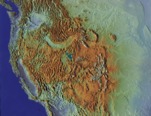
![]()
Simpson and Anders, Topography of the Western United States of America,
1992, at resolution of 1 km.
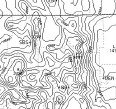
American, Topographic map of a mountainous area of Colorado
and Wyoming. Here topography is portrayed by the use
of contour lines, each delineating
the boundary of terrain of a certain altitude — at intervals
of 300 meters. This area
can also be found on the Simpson and Anders map above, at the
eastern edge of the mountains. Three locations are indicated:
DEN for Denver, SBS for Steamboat Springs, and ABS for the Arapahoe
Basin ski area.
Also see environment art, plan, and landscape.
![]()
![]()
![]() torchon - A tightly rolled paper
stump, or stomp, used for
drawing with powdered pigment
such as charcoal or graphite.
torchon - A tightly rolled paper
stump, or stomp, used for
drawing with powdered pigment
such as charcoal or graphite.
(pr. tohr-SHAW)
Also called a tortillon.
toreutics - The art of working metal or other materials by the use of embossing, chasing, engraving, and fine carving, to form minutely detailed reliefs.
(pr. tə-ROO-təks)
torii - In Japanese tradition, the gateway of a Shinto temple, consisting of two column supporting a concave crosspiece with projecting ends and a straight crosspiece beneath it.
Example:

Japan, Miyajima Island, Torii of Itsukushima, painted
construction of heavy timber.
"Built on axis with
the sea-facing shrine, the gate serves to welcome spirits of
the departed as they come in across the water of Japan's Inland
Sea. At low tide, visitors walk around the great column
of the structure, measuring
its great size against the human body. At high tide, the rugged
vermilion gateway seems to float in the waves around it, a gateway
for boats, or for spirits indeed." Kevin Matthews.
Also see Japanese art.
torsi - A plural of torso.
torso - A statue of the human body with the head and limbs either omitted or removed. May also refer to the trunk of the human body or to a thing that is truncated or unfinished. The plural can be either torsos or torsi.
Examples:

Francis Picabia, Conversation II, c. 1922, watercolor on composition board, 17 7/8 x 23 7/8 inches (45.4 x 60.6 cm), Museum of Modern Art, NY. See Dada.

Naum Gabo (worked in Germany, England, and
USA, born Russia, 1890-1977), Model for 'Constructed Torso', 1917,
reassembled 1981, cardboard,
39.5 x 29.0 x 16.0 cm, Tate Gallery, London. See Constructivism
and model.

Henri Gaudier-Brzeska (English, born France,
1891-1915), Torso, 1914, marble, 25.2 x 98.2 x 7.7 cm, Tate Gallery,
London.

Pearlstein (American, 1924-), Nude Torso, 1963, oil on canvas, 37 1/4 x 45 ¼ inches, National Academy of Design, NY. See realism.

Manuel Neri (American, 1930-), Untitled, 1991, Carrara marble on Carrara marble base,
91 x 27 x 23 1/2 inches, Kemper Museum of Contemporary Art, Kansas
City, MO.
![]()
![]()
![]() tortillon - A tightly rolled paper
stump, or stomp, used for
drawing with powdered pigment
such as charcoal or graphite.
(pr. TOR-tee-yahn) Also called a torchon.
tortillon - A tightly rolled paper
stump, or stomp, used for
drawing with powdered pigment
such as charcoal or graphite.
(pr. TOR-tee-yahn) Also called a torchon.
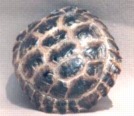
tortoiseshell or tortoise-shell or tortoise shell - The mottled, translucent, brownish covering of the shells of certain tortoises or turtles, especially the hawksbill, used to make combs, eyewear, jewelry, and other objects. It is formed of the same protein substance (keratin) which forms horns, hoofs, claws, and other parts of some animals. Pictured here is a Russian tortoise shell, one of many species. Beware: some species may be endangered. "Tortoiseshell" is sometimes used to refer to a faux or synthetic imitation of this material.
Examples:

Dutch [Amsterdam?] or French, Le Nouveav Testament, c'est à Dire, la
Nouvelle Alliance de Nostre Seigneur Jesus Christ, 1649?,
12 x 7 cm, tortoise shell binding
with metal bosses,
edge guards, hinges and clasps, and gauffered edges,
U of Miami, FL.
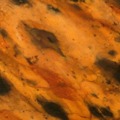
American, detail of faux tortoiseshell painting, from Evergreene
Painting Studios, Inc., New York City. See faux
and marbling.
Also see veneer.
total work of art - See universal artwork.
totem and totem pole - A totem is a representation of an animal, a plant, or a natural object that serves among certain tribal or traditional peoples as an emblem or as a guardian. Or, the animal, plant or natural object itself.
A totem pole is a traditional form among artists of various Native peoples of the "Northwest Coast" — British Columbia, Canada and southern Alaska, USA. Carved from mature cedar trees, full size totem poles were originally an important part of the Potlatch ceremony, a feast with deep meaning to coastal First Nations. Totem poles were once carved and raised to represent a family-clan, its kinship system and stories. A totem pole served, in essence, as the emblem of a family or clan and often as a reminder of its ancestry. It might be raised to honor of a deceased elder, or to show the (great) number of names and rights a person had acquired over their lifetime, or to record an encounter with a supernatural being, or to symbolize the generosity of a person who sponsored a Potlatch ceremony. Contemporary totem poles are carved for both Natives and non-Natives, and have come to represent Northwest Pacific Coast Native tradition and pride. The adjectival form of totem is totemic.
Example:
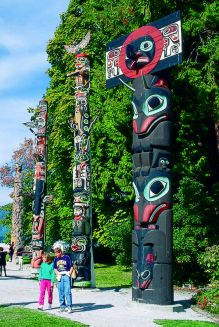
Contemporary totem poles sited in Vancouver,
British Columbia, Canada.
Related resource:
Also see wood.
tow - Coarse broken flax or hemp used as a binder in clay or plaster. Used also to smooth clay or ceramic bodies, especially after casting and before they are fired.
(pr. toh)
toxic - Poisonous;
capable of causing injury or death. Among toxic art materials
are many solvents and adhesives; the paints
flake white (white lead), whose
dry pigment should never
be handled, and Naples yellow. If a material is toxic, the nature
of this concern should be described on its Material
Safety Data Sheet (MSDS). Whenever a person has been exposed
to such hazardous substances
immediately get medical assistance. The study of toxicity is called
toxicology.
See a questionable expert's advice to artists about diet and exercise.
Also see ASTM International (American Society for Testing and Materials), caustic, cleaning art, clean up, flammable, solvent, toluene, volatile, and xylene.
https://inform.quest/_art
Copyright © 1996-![]()